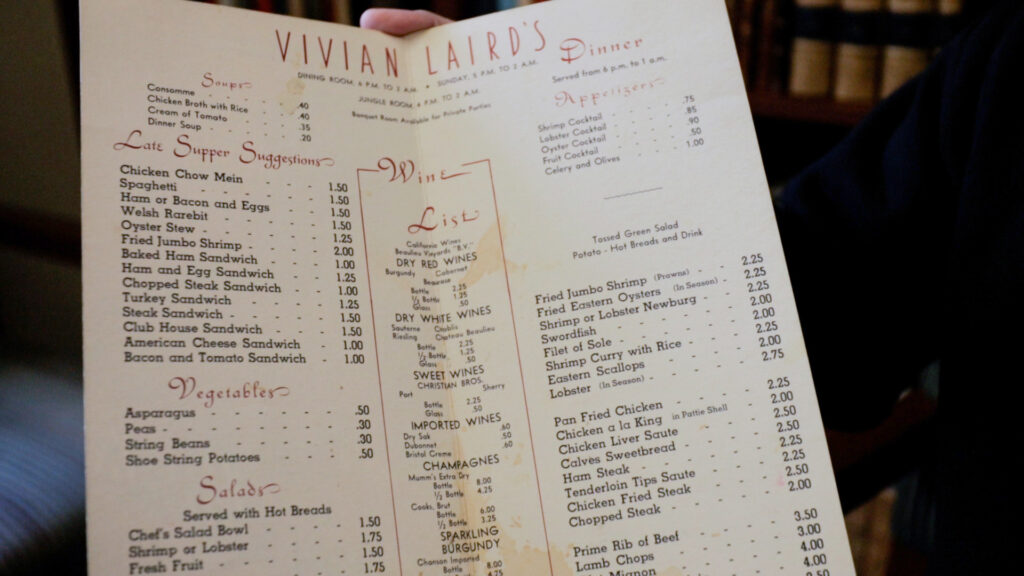If you could go back in time, would you?
The Los Angeles Public Library menu collection may be the closest you can get to reliving a special memory. For years, LAPL has been collecting menus from restaurants around the Los Angeles area, preserving moments in time to revisit for years to come.
“These menus tell us so much about the area they were in,” Ryan Peña, a metadata librarian with the Digitization and Special Collections Department at LAPL, said. “Looking at the demographics from the areas that these restaurants were in, it’s changed quite a bit.”
The collection has 16,000 menus from the early 1900s to the current day and is still growing through donations and purchases from vendors. When the collection first began, menus from all over the world were accepted, but in recent years, the library has limited new intakes to just Los Angeles.
As a metadata librarian, Peña spends his days providing descriptions and making different items searchable within the special collections.
The process of getting a menu into the collection is labor intensive. It begins with making sure the menu is clean (no mold or any coffee or syrup stains for example), but unlike rare books which usually have bookmarks or tissue stuck between the pages, menus are kept for the most part as is.
“You’ll see a menu with a clip with the Friday special still in it,” Peña said. He’s referring to a menu archivists dated between 1949 and 1960 for Chas Savity, a restaurant at Ocean Boulevard and Locust serving chopped liver, breaded veal cutlet and more that particular Friday.

The restaurant has since shuttered, but the collection turns back the clock on some restaurants that are still around. A Second Street staple, Legends, has a menu in the collection that isn’t dated but shows a Seahawk Crab Sandwich priced at just $6.35.
A Hof’s Hut’s menu in the collection from 1994 shows the restaurant’s large repertoire, serving everything from sandwiches and burgers to seafood, fajitas, pasta, stir fry and more. A Hofburger, which came with fresh ground chuck, lettuce, tomatoes, pickles and Thousand Island dressing on a sesame seed bun, would’ve cost just $4.75
A Yugoslavian restaurant Kalemegdan on Redondo was mentioned in a Washington Post article “Where to Eat at the Olympics” published in 1984. The article also mentioned The Mardi Gras, a Mexican-Brazilian fusion restaurant that was on Shoreline Village Drive. Its menu, dated roughly between 1983 and 1995, is also in the collection.
The 1950s Vivian Laird’s menu in the collection is the last remaining piece of the restaurant which was located on First and Alamitos and contained a mural by popular Southern California artist Frank Bowers. They served calves sweetbread (general the thymus or pancreas), chicken liver, lobster and more.

The oldest Long Beach menu in the collection is the Hotel Virginia menu from 1926, the menu doubled as a postcard for patrons to send to loved ones. The hotel stood on Ocean Boulevard between Chestnut and Magnolia avenues.
Some menus, like the Hotel Virginia, make it easy for archivists because they have the date printed on the menu itself. When restaurants printed a new menu each day, the date was included. On menus that don’t have the date, it takes a bit of detective work.
“A lot of research goes into that,” Peña said. “It could be just checking prices and getting an idea of the prices, maybe the photos that are included on the menu as well.”
Inflation, looking at an address to see when the building was there, and food trends all play a part in the process.
“Sometimes we’re able to narrow it down within five years or so,” Peña said. “Sometimes it goes to about 20 years because we can’t quite nail it down.”
View their menus online here or book an appointment request to view them in-person. A library card is not needed for in-person appointments, only a valid government ID.
If you have old menus you’d like to donate, the Long Beach Historical Society is happy to take them. Check out their website for more information.

